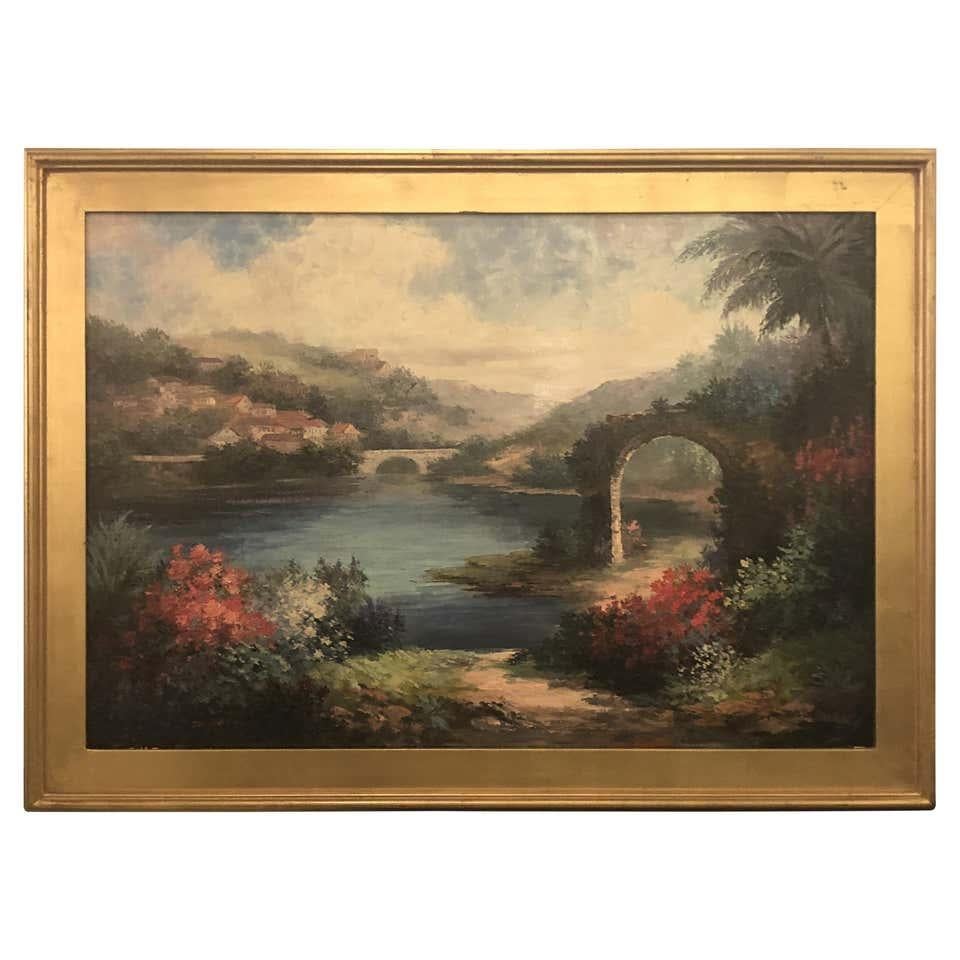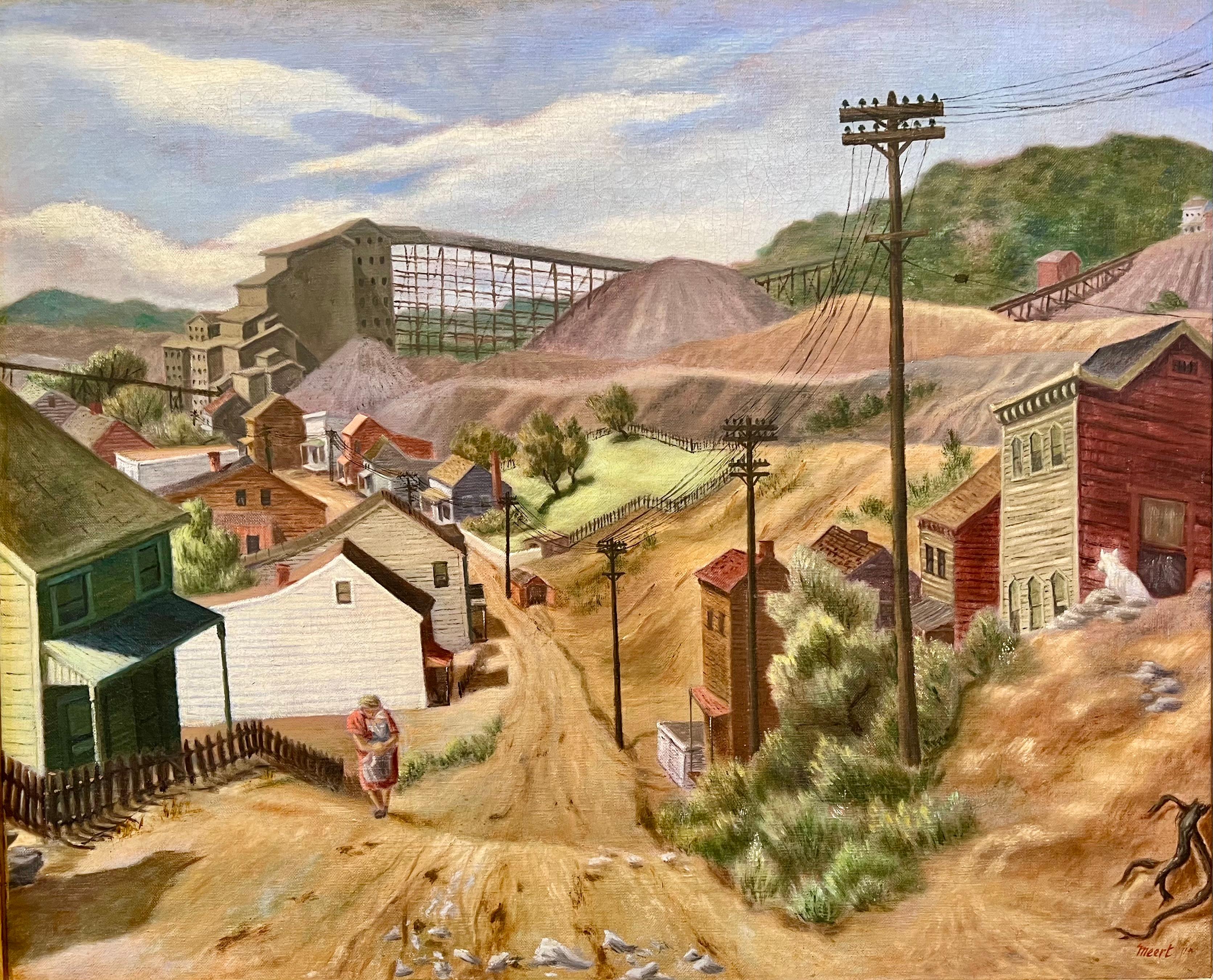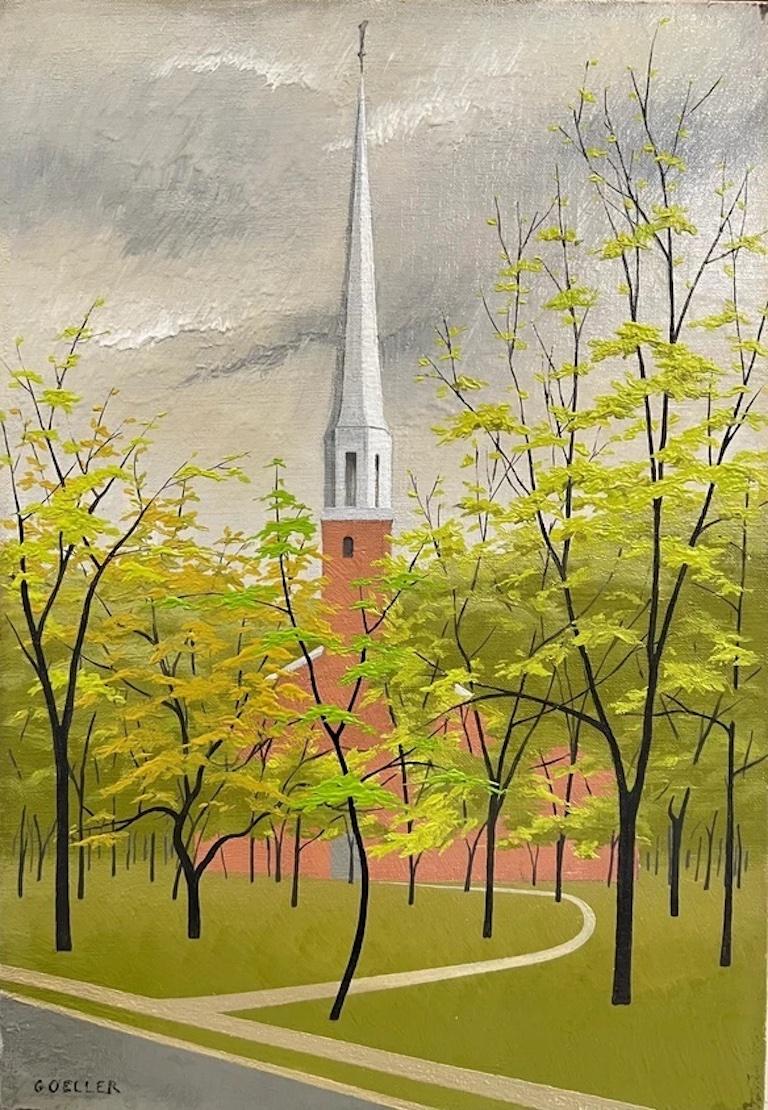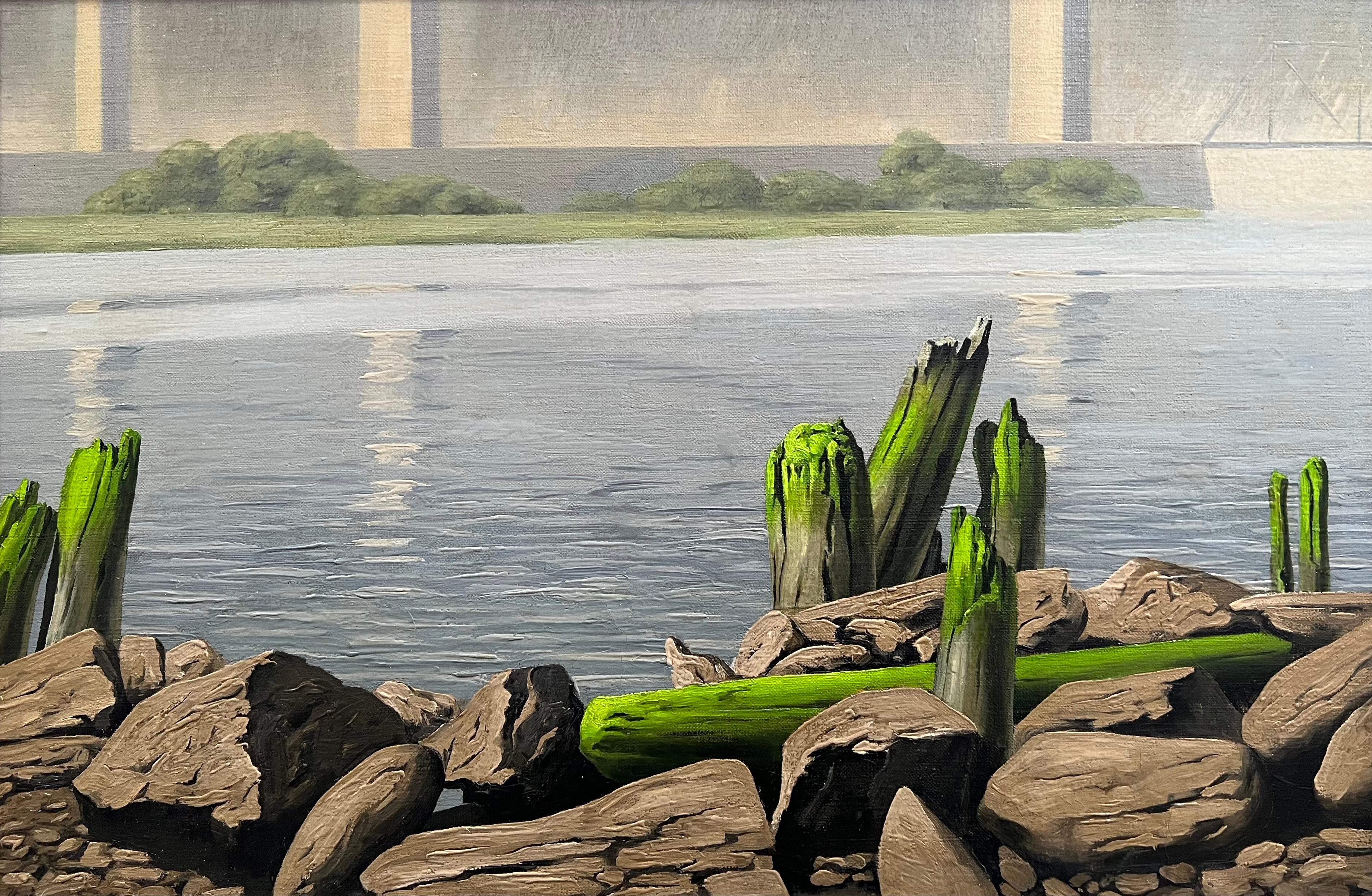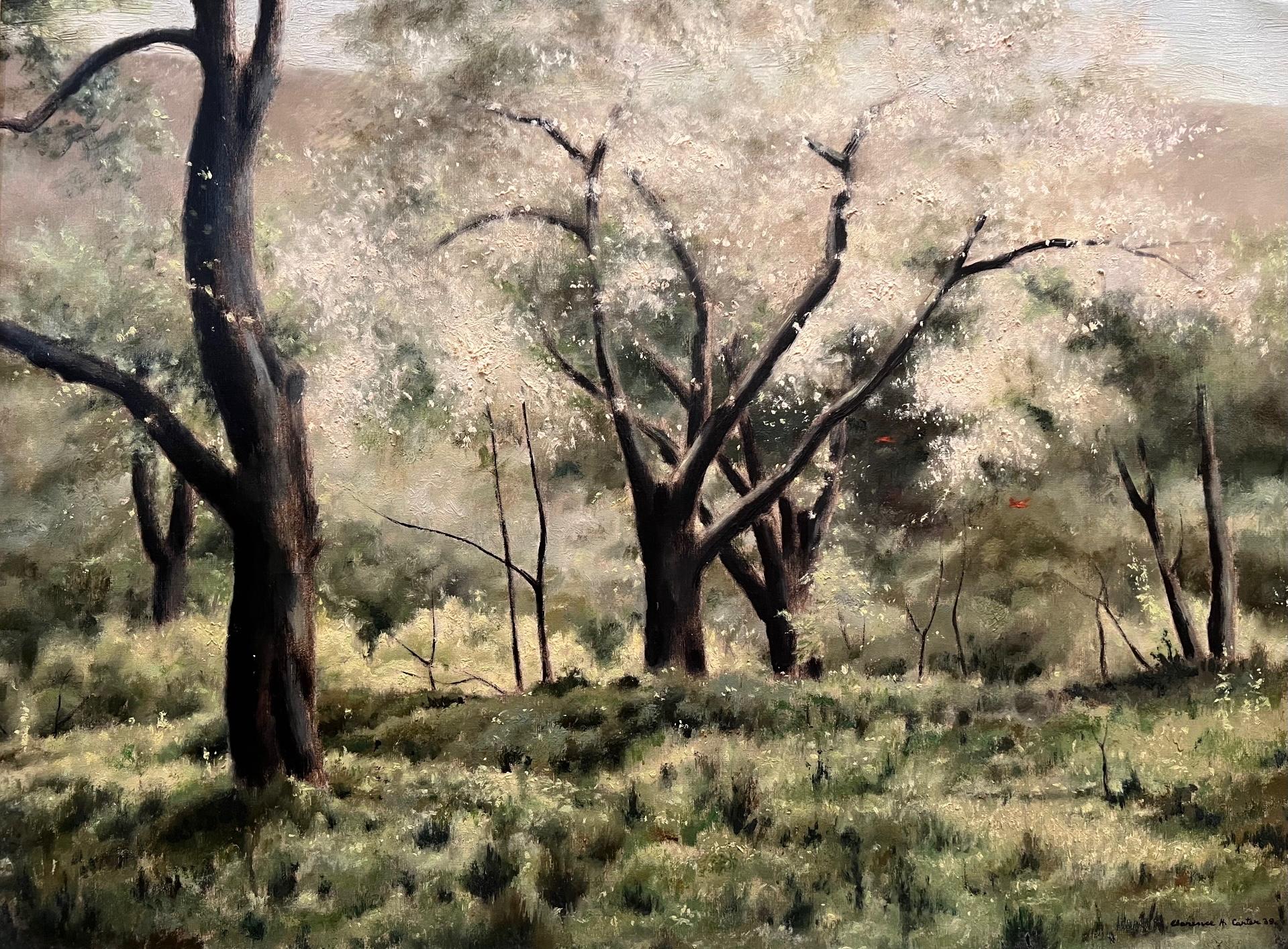Items Similar to "Buttermilk Bay, Cape Cod, " Georgina Klitgaard, Woodstock School Female WPA
Want more images or videos?
Request additional images or videos from the seller
1 of 9
Georgina Klitgaard"Buttermilk Bay, Cape Cod, " Georgina Klitgaard, Woodstock School Female WPA1932
1932
About the Item
Georgina Klitgaard (1893 - 1976)
Buttermilk Bay, Cape Cod, Massachusetts, 1933
Oil on canvas
18 x 30 inches
Signed lower right
Provenance:
Frank K. M. Rehn Galleries, New York
Harold Ordway Rugg
Private Collection, Western New York
Georgina Berrian was born in Spuyten Duyvil, New York in 1893. She was educated at Barnard College and studied at the National Academy of Design in New York. She married the Danish-born mariner, artist, and writer Kaj Klitgaard in 1919. After visiting friends in Woodstock, the couple became committed to the area and built a home in 1922 in Bearsville which provided a panoramic view of the mountains and valleys of Woodstock.
Georgina Klitgaard's first exhibition in New York was held at the Whitney Studio Club from Dec.20, 1927 to January 7, 1928. Klitgaard's New York dealer was the Frank Rehn Galleries, where she began to exhibit in the 1930s, continuing that relationship into the 1950s. In 1939 and again in 1940 she had solo exhibitions with the Milch Gallery in New York. By the late 1920s, Klitgaard began to show works at museum invitationals. She sent work to the Carnegie International in Pittsburgh, Pennsylvania each year from 1928 to 1949. The Corcoran Gallery of Art in Washington, DC invited Klitgaard to exhibit each year from 1930 to 1945. Klitgaard also exhibited works at the Virginia Museum of Fine Art in Richmond and the Pennsylvania Academy of the Fine Arts in Philadelphia from 1930 to 1945 annually.
Klitgaard was also invited to exhibit regularly at the Whitney Museum of American Art from 1927 to 1944. In the 1936 works on paper component of the Whitney Biennial, Klitgaard exhibited Florida Landscape (No.116, a work on paper). In 1944 Klitgaard exhibited another Florida work, Early Spring, Florida (No. 7) at the Whitney. Based on this information, it seems likely that Klitgaard began to visit Florida in the winter during the 1930s and continued to do so until the 1940s. Many of her Woodstock artist friends, such as Doris Lee (1905-1983), found a way to spend time in Florida during the winter on a regular basis. Their experiences in Florida may have influenced Klitgaard to visit.
In 1933 Georgina Klitgaard received a Guggenheim Fellowship which provided funds to travel in Europe. In 1940 the family traveled around the U.S. while Kaj, himself now the recipient of a Guggenheim, wrote Through the American Landscape. During the Depression she was selected to paint murals in post offices in Pelham, Georgia and Goshen (1937) and Poughkeepsie (1940) in Upstate New York. The Metropolitan Museum of Art acquired Girl and Child Under A Pine Tree, a colorful portrait, in 1939. By the 1940s Klitgaard's work was also in the permanent collections of the Whitney Museum of American Art; the Newark Museum; the New Britain Museum of American Art; and the Dayton Art Institute, as well as other public and private collections.
Klitgaard was a member of the Audubon Artists and the American Society of Painters, Sculptors, and Gravers. She had a studio in New York City located at 659 Fifth Avenue. Klitgaard died in 1976. In Klitgaard's estate a few works from her travels to Georgia, Florida, and North Carolina remain, in addition to her summer work in Rhode Island and Nantucket. However, the bulk of her exhibited subjects were painted around the Woodstock or Bearsville area.
- Creator:Georgina Klitgaard (1893-1976, American)
- Creation Year:1932
- Dimensions:Height: 22.5 in (57.15 cm)Width: 34.5 in (87.63 cm)
- Medium:
- Movement & Style:
- Period:
- Condition:
- Gallery Location:New York, NY
- Reference Number:1stDibs: LU1841212443002
About the Seller
5.0
Platinum Seller
These expertly vetted sellers are 1stDibs' most experienced sellers and are rated highest by our customers.
Established in 2021
1stDibs seller since 2022
59 sales on 1stDibs
Typical response time: 1 hour
- ShippingRetrieving quote...Ships From: New York, NY
- Return PolicyA return for this item may be initiated within 3 days of delivery.
More From This SellerView All
- "Tree, Trunk, and Roots, New York" Joseph Stella, American ModernismBy Joseph StellaLocated in New York, NYJoseph Stella (1877 - 1946) Tree, Trunk, and Roots, Bronx, New York, circa 1924 Oil on canvas 12 x 16 inches inscribed in another hand Joseph Stella/Estate and bears Joseph Stella Estate stamp (on the reverse) Provenance: The Estate of the Artist Rabin & Kreuger, New Jersey Parke Bernet Galleries, New York, March 14, 1968, Lot 147 ACA Galleries, New York Thence by descent Stella was born June 13, 1877 at Muro Lucano, Italy, a mountain village not far from Naples. He became painter laureate of Muro Lucano when he was in his teens with a representation of the local saint in the village church. Stella immigrated to America in 1896 and studied medicine and pharmacology, but upon the advice of artist friend Carlo de Fornaro, who recognized his undeveloped talent, he enrolled at the Art Students League in 1897. Stella objected to the rule forbidding the painting of flowers, an indication of his lifelong devotion to flower painting. He also studied under William Merritt Chase in the New York School of Art and at Shinnecock Hills, Long Island in 1901-1902, displaying the bravura brushwork and dark Impressionist influence of Chase. Stella liked to paint the raw street life of immigrant society, rendering this element more emotionally than the city realists, the Aschcan School headed by Robert Henri. Stella went through a progression of styles--from realism to abstraction--mixing media and painting simultaneously in different manners, reviving styles and subjects years later. The "Survey" sent Stella to illustrate the mining disaster of 1907 in Monongah, West Virginia, and in 1908 commissioned him to execute drawings of the Pittsburgh industrial scene. Steel and electricity became a major experience in shaping his responses to the modern world, and Stella succeeded in portraying the pathos of the steelworkers and the Pittsburgh landscape. Stella went abroad in 1909 at the age of thirty-two, lonely for his native land. He returned to Italy, traveling to Venice, Florence and Rome. He took up the glazing technique of the old Venetian masters to get warmth, transparency, and depth of color. One of Stella's paintings was shown in the International Exhibition in Rome in 1910 and was acquired by the city of Rome. The influence of the French Modernists awakened his dormant individuality. His friendship with Antonio Mancini, a Futurist, also played a role in his new style. At the urging of Walter Pach...Category
1920s American Modern Landscape Paintings
MaterialsCanvas, Oil
- "Manhattan Looking East, " Herman Rose, WPA New York City View from MidtownBy Herman RoseLocated in New York, NYHerman Rose (1909 - 2007) Manhattan Looking East (View from Midtown), 1952-54 Oil on canvas 26 x 28 inches Signed lower right Fairfield Porter wrote an essay in ArtNews on this exact painting in 1955. Please inquire for a copy of the article. Literature: Fairfield Porter, "Herman Rose Paints a Picture," ArtNews, April 1955 Volume 54, Number 2, illustrated. Herman Rose was best known for his depictions of cityscapes of New York City. Herman Rappaport was born in Brooklyn, New York. in 1909. Herman Rose was the professional pseudonym of Herman Rappaport. Originally trained as a draftsman and studied at the National Academy of Design from 1927 to 1929, he was later employed by the Works Progress Administration's Murals Division under Arshile Gorky from 1934 until 1939. In 1939, after experimenting with a variety of contemporary expressionistic styles, Rose decided to paint from life. Working mostly in East New York and East Canarsie in Brooklyn, and in Manhattan, Rose began to paint roof tops and street scenes. Rappaport began using the name Herman Rose when he held his first solo art exhibition in 1946 at the Charles Egan Gallery in New York City. Although he initially began as an Expressionistic painter, he became known for small, light-filled Impressionist paintings of still life, cityscapes and skies by the early 1950s. His paintings and images were often composed of very small dabs of paint and tiny, blurry "squares," which combined to create the image on canvas, his favorite medium. Often described as a "lyrical painter" Rose's work "interpreted traditional subjects: landscape, still life and the figure like the Post-Impressionists from whom he developed his own style, Rose built up forms from distinct touches of color that don't entirely blend in the viewer's eye. This gives his surfaces an active quality that flattens forms, one of the great lessons of modernism." Herman Rose's work received official recognition when Ms. Dorothy Miller of Museum of Modern Art (MoMA) included his work in an exhibition called, "15 Americans," alongside work by Clyfford Still, Mark Rothko and Jackson Pollock. New York Times art critic Hilton Kramer wrote of Rose's work in 1981, "{he} must surely be counted among the most beautiful works anyone has produced in this challenging medium for many years." The Art in America art critic Lawrence Campbell...Category
1950s American Modern Landscape Paintings
MaterialsCanvas, Oil
- "New York City Harbor, " Modernist View of Port and Boats on a Cloudy DayBy Bela de TirefortLocated in New York, NYBela De Tirefort (1894 - 1993) New York City Harbor, 1932 Oil on canvasboard 14 x 18 Signed and dated lower left: De Tirefort 32 Bela de Tirefort was born in Eastern Europe, painted...Category
1930s American Modern Landscape Paintings
MaterialsCanvas, Oil, Board
- "Bucolic Landscape, " Sally Michel Avery, Female American Modernist Bright PastelBy Sally Michel-AveryLocated in New York, NYSally Michel Avery (1902 - 2003) Bucolic Landscape with Cows, 1963 Oil on canvasboard 9 x 12 inches Signed and dated lower left Provenance: The art...Category
1980s American Modern Landscape Paintings
MaterialsBoard, Canvas, Oil
- "Mexican Mountains, " Hendrik Glintenkamp, Modernist LandscapeBy Hendrik GlintenkampLocated in New York, NYHendrik (Henry) J Glintenkamp (1887 - 1946) Mexican Mountains, 1940 Oil on canvas 32 x 26 inches Signed lower left; signed and dated on the reverse T...Category
1940s American Modern Landscape Paintings
MaterialsCanvas, Oil
- "Colorado Landscape, " Western Precisionist Regionalism American Scene PaintingBy William SandersonLocated in New York, NYReminiscent of an Edward Hopper or Andrew Wyeth scene, or even Charles Demuth with its cubist elements. William Sanderson (1905 - 1990) Colorado Landscape Oil on canvas 23 1/2 x 31 1/2 inches Signed lower right: Sanderson Born in Dubbeln, near Riga, Latvia in 1905, his personal journey from Czarist Russia, to New York City, and finally to Colorado, is one of remarkable courage and perseverance. Sanderson exhibited in numerous solo and group exhibitions throughout Colorado and the West between 1945 and 1985, and he was voted one of Colorado's influential artists of the 20th Century. Sanderson's paintings are represented in many museums and are sought after by collectors who appreciate his composition and precise use of color. The year 2005 marked the Centennial of Sanderson's birth, and he is now recognized as a major contributor to the development of modern art in Colorado. As a student at the National Academy of Design in 1927, Sanderson exemplifies an individual dedicated to creativity and the life-long passion for art. Known primarily as a Colorado artist, Sanderson first developed his skills as a graphic illustrator in New York City, and his work has appeared in numerous magazines, including New Yorker and New Masses. Notable book illustrations include The Jumping Off Place - 1929, by Marion Hurd McNeely, Jews Without Money - 1930, by Michael Gold...Category
Mid-20th Century American Modern Landscape Paintings
MaterialsCanvas, Oil
You May Also Like
- Americana Landscape Oil on Canvas Painting Signed P. Paul, FramedLocated in Plainview, NYAn elegant oil on canvas landscape painting featuring a lake view in a paradisiac environment. The painting is finely framed in custom giltwood frame. A wonderful addition to any liv...Category
1980s American Modern Landscape Paintings
MaterialsOil, Canvas
- Six O'ClockLocated in Los Angeles, CASix O-Clock, c. 1942, oil on canvas, 30 x 20 inches, signed and titled several times verso of frame and stretcher (perhaps by another hand), marked “Rehn” several times on frame (for the Frank K. M. Rehn Galleries in New York City, who represented Craig at the time); Exhibited: 1) 18th Biennial Exhibition of Contemporary American Oil Paintings from March 21 to May 2, 1943 at The Corcoran Gallery of Art in Washington, D.C. #87, original price $450 (per catalog) (exhibition label verso), 2) Craig’s one-man show at the Frank K. M. Rehn Galleries, New York City, from October 26 to November 14, 1942, #10 (original price listed as $350); and 3) Exhibition of thirty paintings sponsored by the Harrisburg Art Association at the State Museum of Pennsylvania in Harrisburg in March, 1944 (concerning this exhibit, Penelope Redd of The Evening News (Harrisburg, Pennsylvania) wrote: “Other paintings that have overtones of superrealism inherent in the subjects include Tom Craig’s California nocturne, ‘Six O’Clock,’ two figures moving through the twilight . . . .” March 6, 1944, p. 13); another label verso from The Museum of Art of Toledo (Ohio): original frame: Provenance includes George Stern Gallery, Los Angeles, CA About the Painting Long before Chris Burden’s iconic installation outside of the Los Angeles County Museum of Art, Urban Light, another artist, Tom Craig, made Southern California streetlights the subject of one of his early 1940s paintings. Consisting of dozens of recycled streetlights from the 1920s and 1930s forming a classical colonnade at the museum’s entrance, Burden’s Urban Light has become a symbol of Los Angeles. For Burden, the streetlights represent what constitutes an advanced society, something “safe after dark and beautiful to behold.” It seems that Craig is playing on the same theme in Six O-Clock. Although we see two hunched figures trudging along the sidewalk at the end of a long day, the real stars of this painting are the streetlights which brighten the twilight and silhouette another iconic symbol of Los Angeles, the palm trees in the distance. Mountains in the background and the distant view of a suburban neighborhood join the streetlights and palm trees as classic subject matter for a California Scene painting, but Craig gives us a twist by depicting the scene not as a sun-drenched natural expanse. Rather, Craig uses thin layers of oil paint, mimicking the watercolor technique for which he is most famous, to show us the twinkling beauty of manmade light and the safety it affords. Although Southern California is a land of natural wonders, the interventions of humanity are already everywhere in Los Angeles and as one critic noted, the resulting painting has an air of “superrealism.” About the Artist Thomas Theodore Craig was a well-known fixture in the Southern California art scene. He was born in Upland California. Craig graduated with a degree in botany from Pomona College and studied painting at Pamona and the Chouinard Art School with Stanton MacDonald-Wright and Barse Miller among others. He became close friends with fellow artist Milford Zornes...Category
1940s American Modern Landscape Paintings
MaterialsCanvas, Oil
- Gold Mine, Central City, ColoradoBy Joseph MeertLocated in Los Angeles, CAThis painting is part of our exhibition America Coast to Coast: Artists of the 1930s Goldmine, Central City, Colorado, oil on canvas, 36 x 28 inches, c. 1936, signed lower right, ex collection of Platt Fine Art, Chicago, Illinois (label verso). About the Painting Joseph Meert’s painting, Goldmine, Central City, Colorado, depicts the short-lived resurrection of a once prominent city just outside Denver. Central City was founded in 1859 soon after John Gregory struck gold in the area. As word spread, thousands of miners converged into “Gregory’s Gulch” and its surroundings became known as the “richest square mile on earth.” Mining production quickly increased resulting in Central City to becoming Colorado’s largest city in the early 1860s. Despite some technical difficulties transitioning to lode mining and the rise of competition from Leadville, Central City remained an economic boom town through the turn of the century. But, with every boom, there is a bust. World War I marked the end of Central City’s prominence as ore production ground to a halt and by 1925, the town’s population shrank to only 400 people. The desperation of the Great Depression and a nearly 100% increase in the price of gold lured labor and capital back to Central City. Meert painted in Colorado during the mid-1930s, a time when he created his most desirable works. It is during this period of renaissance that Meert captures one of Central City's outlying dirt streets bordered by 19th century wooden houses from the town's heyday and the more recently installed electric lines leading to a distant gold mine. A lone figure trudges up the hill, a mother with a baby in her arms, putting us in mind of the rebirth of the town itself. Meert had solo exhibitions at the Colorado Springs Fine Arts Center in 1936 and the Denver Art Museum. Although it is not known whether Goldmine, Central City was included in either of these exhibitions, it seems likely. Moreover, the painting is closely related to Meert’s painting, The Old Road, which was painted in 1936 and exhibited at the Corcoran Gallery of Art in Washington, DC and at the Dallas Museum of Art. About the Artist Joseph Meert was a well-regarded painter and muralist, who initially made a name for himself in the American Scene and later as an abstract expressionist. Although initially successful, Meert struggled financially and with mental illness later in life. He was born in Brussels, Belgium, but moved with his family to Kansas City, Missouri. As a child, a chance encounter at the Union Pacific Railyard changed his life. Meert happened upon a worker repainting and stenciling a design on a railroad car. Meert later recalled that this experience introduced him to the idea of being a painter. Without support from his father, Meert obtained a working scholarship to the Kansas City Art Institute. After four years at the Kansas City Art Institute, Meert studied seven years at the Art Students League and in Europe and Los Angeles. At the Art Students League, Meert fell under the spell of Thomas Hart Benton and Stanton MacDonald-Wright. In 1931, he befriended Jackson Pollock. By 1934, Meert was part of the Public Works of Art Project when he met his wife, Margaret Mullin...Category
1930s American Modern Landscape Paintings
MaterialsCanvas, Oil
- Church in TreesLocated in Los Angeles, CAThis painting is part of our exhibition Charles Goeller: A Wistful Loneliness. Oil on canvas, 13 x 9 inches, Signed lower leftCategory
1940s American Modern Landscape Paintings
MaterialsOil, Canvas
- Arthur KillLocated in Los Angeles, CAThis painting is part of our exhibition Charles Goeller: A Wistful Loneliness. Oil on canvas, 15 ¾ x 24 inches, Signed and titled verso on stretcher Exhibited: [Solo Exhibition] Cha...Category
1940s American Modern Landscape Paintings
MaterialsCanvas, Oil
- Trees at BloomBy Clarence Holbrook CarterLocated in Los Angeles, CATrees at Bloom, 1939, oil on canvas, 32 x 24 inches, signed lower right About the Painting Trees at Bloom was painted when Clarence Holbrook Carter lived in Pittsburgh and served as an instructor in the Department of Painting and Design at the Carnegie Institute of Technology (now Carnegie-Mellon University), a position he held from 1938 through 1944. It depicts a thick forest at the base of distance hills just outside the city. During his tenure in Pittsburgh, Carter was deeply influenced by not only the industrial might of the steel mills and iron forges of the city, but also the beauty of the surrounding landscape. As Frank Anderson Trapp noted in his book on the artist, for Carter “the terrain itself had its own special vitality, with its craggy, wooded hills threaded with ravine and watercourses . . . . the signs of industrial blight that were unalleviated in some parts of the country were there relieved by the geological variety of the parent landscape, and by the irrepressible presence of its natural growth, which softened the whole.” Trapp continues, “in his scenes of rural situations, Carter had a special gift for rendering those elements convincingly.” With the profusion of flowering trees which diffuse the light and the red cardinals darting from one branch to another, Trees at Bloom portrays the “irrepressible presence of nature” that Trapp describes. About the Artist Together with Charles Burchfield, Clarence Holbrook Carter was Ohio’s premiere American Scene painter and later an innovative magic realist. The son of a no-nonsense public-school administrator, Carter was born in 1904 outside of Portsmouth, Ohio, a small town in the heart of the Ohio River...Category
1930s American Modern Landscape Paintings
MaterialsCanvas, Oil
Recently Viewed
View AllMore Ways To Browse
Max Robert Theynet
Nathalie Grange
Nestled In Chianti
Nicholas Kilner
O R De Jongh
Oh De Laval
Oscar Ricciardi On Sale
Pablo Segarra Chias Painting
Pierre Laurent Baeschlin
Ramon Perez Barril
Regis De Bouvier De Cachard
Ring Of Kerry
Robert N Blair
Rolla Sims Taylor
Ross Penhall
Schuyler Standish On Sale
Sergei Kovalenko On Sale
Sergio Roffo
